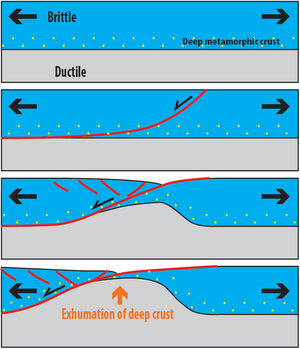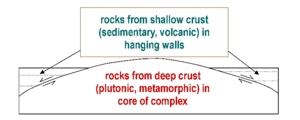مجمع لب متحول
مجمع لب متحول (وجمعها مجمعات الألباب المتحولة) أو مجمع نواة متحولة Metamorphic core complexes هي مناطق مكشوفة من القشرة العميقة التي جلبتها إلى السطح crustal extension (stretching).[1] They form, and are exhumed, through relatively fast[بحاجة لمصدر] transport of middle and lower continental crust to the Earth's surface[2] in the form of uplifting welts of hot rock and magma.[1] The resulting doming causes the overlying rock to gravitationally collapse, sliding down and usually away from the uplift along low-angle detachment faults.[1] Brittle, faulted cover rock above the detachment surface lies in direct contact with the ductile middle-lower crust below.[3]
High-grade metamorphic rocks (eclogite-, granulite- to amphibolite- facies) are exposed below the detachment faults (and mylonitic shear zones).[بحاجة لمصدر] Amphibolite- to greenschist-facies, syndeformational metamorphism, and ductile-brittle to brittle deformation are shown on the upper-side (hanging-wall), with tilted geometries.[بحاجة لمصدر]
They range from several miles to over 50 miles across, and usually exhibit several miles of vertical uplift.[1] They are common in areas of localized crustal extension in otherwise thickened fold-thrust belts.[1][مطلوب توضيح] The origin of the low angles of the detachment faults were a subject of debate as of 2022.[3]
أوصاف
- Coney (1980) stated that they:[4]
are characterized by a generally heterogeneous, older metamorphic-plutonic basement terrane overprinted by low-dipping lineated and foliated mylonitic and gneissic fabrics. An unmetamorphosed cover terrane is typically attenuated and sliced by numerous subhorizontal younger-on-older faults. Between the basement and cover terranes is a decollement and/or steep metamorphic gradient with much brecciation and kinematic structural relationships indicating sliding or detachment.
The decollement is also called a detachment fault.
- According to Lister and Davis (1989):[2]
Metamorphic core complexes form as the result of major continental extension, when the middle and lower continental crust is dragged out from beneath the fracturing, extending upper crust. Movement zones capable of producing such effects evolve in space as well as with time. Deforming rocks in the footwall are uplifted through a progression of different metamorphic and deformational environments, producing a characteristic sequence of (overprinted) meso- and microstructures.
الموقع
The core complex model was first developed in the cordillera of western North America,[5] with older cores found in the north (Eocene), and younger to the south.[بحاجة لمصدر] The structures were first described by Peter Misch and his students in 1960.[5] They were formerly called "cordilleran core complexes" after the region in which they were discovered.[5] Globally, core complexes are thought to be found in the Aegean Sea,[6] Anatolia, Iran, Tibet, north China, Slovakia,[7] Venezuela-Trinidad (Miocene), New Zealand and West Antarctica.[8] Core complexes are currently continuing to form in eastern New Guinea.[9]
مجمعات الألباب في الكواكب الأخرى
A feature at the center of Artemis Corona on Venus has been suggested as a metamorphic core complex.[10] This could be the largest metamorphic core complex in the solar system.
انظر أيضاً
المراجع
- ^ أ ب ت ث ج "What is a Metamorphic Core Complex". Utah Geological Survey.
- ^ أ ب Lister, G.S.; Davis, G.A. (1989). "The origin of metamorphic core complexes and detachment faults formed during Tertiary continental extension in the northern Colorado River region, U.S.A." (PDF). J. Struct. Geol. 11 (1–2): 65–94. Bibcode:1989JSG....11...65L. doi:10.1016/0191-8141(89)90036-9.
- ^ أ ب Bahadori, Alireza; Holt, William E.; Austermann, Jacqueline; Campbell, Lajhon; Rasbury, E. Troy; Davis, Daniel M.; Calvelage, Christopher M.; Flesch, Lucy M. (2022-09-26). "The role of gravitational body forces in the development of metamorphic core complexes". Nature Communications (in الإنجليزية). 13 (1): 5646. Bibcode:2022NatCo..13.5646B. doi:10.1038/s41467-022-33361-2. ISSN 2041-1723. PMC 9513114. PMID 36163354.
- ^ Coney, P.J. (1980). Crittenden, M.D.; Coney, P.J.; Davis, G.H. (eds.). "Cordilleran Metamorphic Core Complexes". GSA Memoir. Geological Society of America. 153: 7–34. doi:10.1130/MEM153-p7.
- ^ أ ب ت Crittenden, Max D.; Coney, Peter J.; Davis, George Herbert; Davis, George Hamilton (1980). "Cordilleran Metamorphic Core Complexes: An Overview" (PDF). Cordilleran Metamorphic Core Complexes (in الإنجليزية). Geological Society of America. ISBN 978-0-8137-1153-9.
- ^ Philippon, M. (2014). Philippon, M.; Brun, J.-P.; Gueydan, F.; Sokoutis, D. (eds.). "The interaction between Aegean back-arc extension and Anatolia escape since Middle Miocene". Tectonophysics. 631: 176–188. Bibcode:2014Tectp.631..176P. doi:10.1016/j.tecto.2014.04.039. S2CID 53683418.
- ^ Janák, M.; Plašienka, D.; Frey, M.; Cosca, M.; Schmidt, S. TH.; Lupták, B.; Méres, Š. (February 2001). "Cretaceous evolution of a metamorphic core complex, the Veporic unit, Western Carpathians (Slovakia): P–T conditions and in situ40Ar/39Ar UV laser probe dating of metapelites". Journal of Metamorphic Geology. 19 (2): 197–216. Bibcode:2001JMetG..19..197J. doi:10.1046/j.0263-4929.2000.00304.x. S2CID 129901824.
- ^ McFadden, R.; Teyssier, C.; Siddoway, C. S.; Whitney, D.; Fanning, C. M. (2010). "Oblique dilation, melt transfer, and gneiss dome emplacement". Geology. 38 (4): 375–378. Bibcode:2010Geo....38..375M. doi:10.1130/G30493.1.
- ^ Ӧsterle, J.E.; Little, T.A.; Seward, D.; Stockli, D.F.; Gamble, J. (2020). "The petrology, geochronology and tectono-magmatic setting of igneous rocks in the Suckling-Dayman metamorphic core complex, Papua New Guinea". Gondwana Research. 83: 390–414. Bibcode:2020GondR..83..390.. doi:10.1016/j.gr.2020.01.014. hdl:10468/9725.
- ^ Spencer, J. E. (2001). "Possible giant metamorphic core complex at the center of Artemis Corona, Venus". Geological Society of America Bulletin. 113 (3): 333–345. Bibcode:2001GSAB..113..333S. doi:10.1130/0016-7606(2001)113<0333:PGMCCA>2.0.CO;2. ISSN 0016-7606.
وصلات خارجية
- Metamorphic core complexes
- Cordilleran metamorphic core complexes: Cenozoic extensional relics of Mesozoic compression Peter J. Coney. Tekla A. Harms. Geology, September, 1984

